yeah yeah i'll organize some day, but not today, so go away. make like a tree, and leaf
Don't wanna be here? Send us removal request.
Text
some thoughts about biopolitics, the insanity plea, and total institutions in the comic what happens next by @maximumgraves. you don't necessarily need to have read it to get it but it helps. hope u like it!
359 notes
·
View notes
Text
wikipedia no longer being anywhere near the top of search results when looking up anything feels eviscerating
116K notes
·
View notes
Text
"The exclusion of Black women’s ideas from mainstream academic discourse and the curious placement of African-American women intellectuals in feminist thinking, Black social and political theories, and in other important thought such as U.S. labor studies has meant that U.S. Black women intellectuals have found themselves in outsider-within positions in many academic endeavors. The assumptions on which full group membership are based—Whiteness for feminist thought, maleness for Black social and political thought, and the combination for mainstream scholarship—all negate Black women’s realities. Prevented from becoming full insiders in any of these areas of inquiry, Black women remained in outsider-within locations, individuals whose marginality provided a distinctive angle of vision on these intellectual and political entities.
Alice Walker’s work exemplifies these fundamental influences within Black women’s intellectual traditions. Walker describes how her outsider-within location influenced her thinking: “I believe . . . that it was from this period—from my solitary, lonely position, the position of an outcast—that I began really to see people and things, really to notice relationships”. Walker realizes that “the gift of loneliness is sometimes a radical vision of society or one’s people that has not previously been taken into account”. And yet marginality is not the only influence on her work. By reclaiming the works of Zora Neale Hurston and in other ways placing Black women’s experiences and culture at the center of her work, she draws on alternative Black feminist worldviews."
-Black Feminist Thought: Knowledge, Consciousness, and the Politics of Empowerment by Patricia Hill Collins
3 notes
·
View notes
Text
"Developing Black feminist thought also involves searching for its expression in alternative institutional locations and among women who are not commonly perceived as intellectuals. As defined in this volume, Black women intellectuals are neither all academics nor found primarily in the Black middle class. Instead, all U.S. Black women who somehow contribute to Black feminist thought as critical social theory are deemed to be “intellectuals.” They may be highly educated. Many are not. For example, nineteenth-century Black feminist activist Sojourner Truth is not typically seen as an intellectual.3 Because she could neither read nor write, much of what we know about her has been recorded by other people. One of her most famous speeches, that delivered at the 1851 women’s rights convention in Akron, Ohio, comes to us in a report written by a feminist abolitionist some time after the event itself (Painter 1993). We do not know what Truth actually said, only what the recorder claims that she said. Despite this limitation, in that speech Truth reportedly provides an incisive analysis of the definition of the term woman forwarded in the mid-1800s:
That man over there says women need to be helped into carriages, and lifted over ditches, and to have the best place everywhere. Nobody ever helps me into carriages, or over mud puddles, or gives me any best place! And ain’t I a woman? Look at me! Look at my arm! I have ploughed, and planted, and gathered into barns, and no man could head me! And ain’t I a woman? I could work as much and eat as much as a man—when I could get it—and bear the lash as well! And ain’t I a woman? I have borne thirteen children, and seen them most all sold off to slavery, and when I cried out with my mother’s grief, none but Jesus heard me! And ain’t I a woman?
By using the contradictions between her life as an African-American woman and the qualities ascribed to women, Sojourner Truth exposes the concept of woman as being culturally constructed. Her life as a second-class citizen has been filled with hard physical labor, with no assistance from men. Her question, “and ain’t I a woman?” points to the contradictions inherent in blanket use of the term woman. For those who question Truth’s femininity, she invokes her status as a mother of thirteen children, all sold off into slavery, and asks again, “and ain’t I a woman?” Rather than accepting the existing assumptions about what a woman is and then trying to prove that she fit the standards, Truth challenged the very standards themselves. Her actions demonstrate the process of deconstruction— namely, exposing a concept as ideological or culturally constructed rather than as natural or a simple reflection of reality. By deconstructing the concept woman, Truth proved herself to be a formidable intellectual. And yet Truth was a former slave who never learned to read or write."
-Black Feminist Thought: Knowledge, Consciousness, and the Politics of Empowerment by Patricia Hill Collins
7 notes
·
View notes
Text

Substack: home of Nazis, Covid misinformation, anti-vaccine propaganda & transphobia
(I'm reposting this from my patreon. You can also read it here.)
As the Twitter dumpster fire burns to ashes and artists leave Instagram in droves due to Meta's shit new policies, I have watched more and more friends turn to Substack in the past few months. Please don't do this!! Substack has well-documented problems with platforming literal Nazis, as well as writers spreading Covid misinformation, anti-vaccine propaganda, and transphobia. There has been a major exodus of writers leaving Substack basically every single year since 2021, as the company doubles down and doubles down again at being the welcoming home for people whose views are so extreme and hateful that they've been banned from every other site.
Please read this short article "Substack Has a Nazi Problem: The newsletter platform’s lax content moderation creates an opening for white nationalists eager to get their message out" by Jonathan M. Katz for the Atlantic. Most of the points below are simply in support of this article. If you would like to convince a creator you admire to stop using Substack, sending them this article is a great place to start.
(long post below the cut)
Not only is Substack platforming white nationalists, it is creating a space for them to earn money on their hate. "Some Substack newsletters by Nazis and white nationalists have thousands or tens of thousands of subscribers, making the platform a new and valuable tool for creating mailing lists for the far right. And many accept paid subscriptions through Substack, seemingly flouting terms of service that ban attempts to ‘publish content or fund initiatives that incite violence based on protected classes.’ Several, including [Richard] Spencer’s, sport official Substack ‘bestseller’ badges, indicating that they have at a minimum hundreds of paying subscribers. [...] Substack, which takes a 10 percent cut of subscription revenue, makes money when readers pay for Nazi newsletters.” -Jonathan M. Katz, “Substack has a Nazi Problem” (2023)
We aren’t talking about small amounts of money either. Bari Weiss told Axios in December 2024 that her Substack The Free Press “has 136,000 paying subscribers, which implies a minimum annual revenue of $10.9m based on its $80 yearly subscription price.” -Bron Maher, “More than 50 newsletters earn $500,000+ on Substack” (2025) You might remember Bari Weiss from her constant promoting and platforming of anti-transgender extremism. From 2017 until resigning in 2020, Weiss was a staff writer and editor for the opinion section of the New York Times.
Substack is also platforming folks spreading lies about Covid and vaccines. “Dr. Joseph Mercola, touted as ‘the pioneer of the anti-vaccine movement,’ gained fame during the pandemic for spreading COVID misinformation and offering alternative, false 'cures'. The osteopathic physician has landed official warnings from the FDA for his claims, which span various social media platforms, each with their own content policy regarding health misinformation. In 2021, Mercola found one platform less restrictive on censorship: Substack. [...] There is a burgeoning cluster of anti-vaxxers, white nationalists, and QAnon influencers finding the Substack ecosystem more lenient than others.
Of the current list of top paid political newsletters on Substack, former Times writer Alex Berenson and tech entrepreneur Steve Kirsch come in at sixth and nineteenth respectively, both known for spreading COVID misinformation. Berenson charges $6 per month for his newsletter, while Kirsch is asking for $5. Mercola is number 13, charging $5 per month. Substack takes 10 percent.” -Meera Navlakha, “On Substack, Covid Misinformation is Allowed To Flourish” (2022)
Substack has also allowed transphobia, including the doxxing of multiple trans women, to go unpunished on the site. “Increasingly, Substack is tolerating and funding extreme trans-eliminationist rhetoric: They host Jesse Singal, a high-profile supporter of anti-trans conversion therapy who is also widely known to fixate on and stalk trans women in and around the media industry. I would list Jesse’s targets, but at this point, I don’t know a trans woman in media who doesn’t have a story. Graham Lineham is a transphobic bigot so extreme and abhorrent that he’s been permanently banned from Twitter, Medium, and basically every platform but the one I’m using to talk to you right now. He reportedly considers Substack a major source of income.” -Jude Doyle, a trans author who left Substack (2021)
And if all of that isn’t enough, one of the Substack CEOs posted this blog on January 29, 2025, praising Elon Musk as a supporter of free speech and praising Mark Zuckerberg for the positive changes to Meta’s policies (including allowing hate speech against queer people on Meta sites). “Those who welcome the press freedom changes at Meta owe a debt to those who took a principled stand when the wind was blowing the other way.” -Chris Best (2025)
In conclusion, do not join Substack if you are looking for a site that is more ethical than Twitter or Instagram. Substack is equally as bad or worse. Luckily, if you want to start a newsletter, there are multiple other options, including ones which allow you to gain paid subscribers AND take a smaller cut than Substack does. Three that have risen to the top include Buttondown, Beehiiv, and Ghost. Wired did an article reviewing all three.
Buttondown makes it extremely easy to export all of your archived posts and subscribers from Substack so you don’t lose any followers or writing in a transition from one platform to the other. Buttondown does charge, but if you plan to monetize your blog, they take a smaller cut over time than Substack does. I follow several newsletters that switched from TinyLetter or MailChimp over to Buttondown and as a subscriber, I did not miss a single issue. The one free plan only allows up to 100 subscribers, after which it is $9 per month until 1000 subscribers and then rates increase based on follower count. See the rates generator here.
Beehiiv is also trying to make the transition process easy. Here’s a blog post and a more recent article on how to migrate your subscribers. I don’t personally know anyone who uses this site, but here is a glowing review. Apparently the free plan will allow you to have up to 2,500 subscribers, which is quite generous.
Ghost also has a guide on how to export followers from Substack, as well as from many other sites including Wordpress, Patreon, Mailchimp and more. Ghost charges $9 per month for up to 500 followers for their basic plan, and then rates go up from there based on follower size. See a rates generator here.
And there’s Patreon! Far from perfect, but if you sign up for a new account they take 8% of your subscriber earnings, which is also lower than the 10% Substack takes. I wouldn’t necessarily suggest Patreon if what you really want is a newsletter, but that being said I do use it basically as a newsletter and make the majority of my posts free, like this one.
I know that no internet platform is pure. I know that moving to a new site is a huge hassle. But I am imploring my friends and mutuals not to choose Substack as your new internet home when leaving Twitter, Instagram, Facebook, etc. And if you already have a Substack, please take some time to look at your alternatives. I will leave you with this quote from Imani Grady: “The reason it's really important to leave Substack NOW is their relatively new social networking features. Substack is creating a walled garden that you have to share with white supremacists. They want to keep you on Substack where all the Nazis are and force you to share your revenue with them.”
If you feel like doing further reading, here are links to posts from writers on why they decided to leave Substack, most of which also say where they ultimately moved to:
Margot Atwell (2023), Marisa Kabas (2024), Ryan Broderick (2024), Jude Doyle (2021), Nathan Tankus (2021), Grace Lavery (2022), Sarah Gailey (2021)
1K notes
·
View notes
Text
Editing Part ????: Final Steps (That You'll Repeat)
HI THIS POST WAS SUPPOSED TO GO UP IN JANUARY. Uuuh things. Are happening. In the US. Alas.
ANYWAY, to wrap up our editing tips. Some of this you'll do on your own, some of it you'll need feedback on, a lot of it is going back and forth between various edits. It is a process.
Tone and Voice
In review, is your character's voice consistent? Do they remain solid as a character, or do they wildly change in how they speak and act in the middle of the book for no reason?
When it comes to tone, are you writing with a consistently used vocabulary and structure? I'm not talking about dialogue - does your story feel the same, no matter if it's in third person or first?
A tonal shift or word change might happen if you've been working a long time on a project, and that's just a matter of going back through the book to make sure things match up.
Tension and Pacing
Does the action rise and fall naturally? Are your characters given room to breathe when appropriate?
Have you resolved (or addressed) all your subplots? Did you leave any romance or relationships dangling? Are there any chunks of your book that feel like a side-quest that doesn't contribute to the rest of the plot?
How is your scene pacing? Like your book, your scenes can't be 100% tension - they need to rise and fall. Fights and action should build naturally. If you're dropping a character into a situation with no foreshadowing, or if they obtain some new nifty power without really earning it, you might be throwing the pacing off.
Again, this just takes going back over to see what little things you need to set up to make the pay-off worth it.
Line Edits
Hopefully you've saved this for last, I know you won't, I know I won't, but fiddling with the language is going to be better done at the very end. Look out for:
Overused Words and Phrases - I find with each project, I become overly fond of one particular word. It's useful and fantastic until it pops up a little too often, and then I need to work on changing it up. Same with phrases - if you're brain is like mind, it'll find a neat little turn of phrase and repeat that six or eight times when you only needed it once.
Hedging Words - Almost, nearly, not quite, seems, appears, etc - these words are perfectly fine in academic writing, but they weaken your descriptive work. Instead of saying "he almost hit me" for example, describe the motion and the character's reaction. If someone seems upset, how can you describe that through their body language?
Dialogue Tags - You can use fun dialogue tags, and you don't have to delete every -ly abverb attached to "said." However, as boring as it seems, keeping it simple with mostly using "said" and "replied" will do most of the job.
Re-Checking Sentence Structure - If all your sentences within a paragraph follow the same structure, your reader is likely to start to skim. Change things up with shorter sentences paired with longer ones. Chunk actions scenes with short, punchy sentences, make sure descriptive paragraphs don't have sentences that go on for way too long.
Feedback
There's no easy way to find a good critique partner. I wish there was. You can and should join writer's groups and offer exchanges, be they online or in person. Sometimes you can love someone's work, but you don't mess with them as a critique partner. It happens, keep trying.
When you do find a critique partner, it's always good to give them guidance on what you're looking for. Some good questions:
Pacing - When did they put the story down? Why?
Consistency - Was anything confusing? Did the character's choices make sense?
Plot - Where there any twists that were too obvious? Did the stakes feel important? Was the plot satisfying?
A Note on "Predictable" Plot
There is a consistent argument about predictive plots versus originality, but thinking too hard about it may lead you astray. Certain genres have expectations - cosy murders will be solved, romance will end with the leads getting together, etc. Readers often go into stories wanting some predictability, because it's the journey of the story that matters the most. Making sure the story is engaging to read is far more important than trying to be original.
That said, you'll find in your second and third drafts that you will be able to put your own design on familiar stories. Treading familiar ground in the first draft is common, but when taking another crack of it, you can raise the stakes and make that ending much more satisfying.
Good luck!
220 notes
·
View notes
Text
Now that gift season is approaching, here's a reminder that local independent bookshops in many countries are organized in websites so you can order whatever book you want and have it delivered. Like Amazon but instead of your money going to a billionaire who mistreats the workers and lobbies politicians to get away with more human right abuses, the money goes to local bookshops. So even if you didn't find what you wanted in your local bookshop (though it's always still worth checking out and the shop keeper will be able to recommend you an alternative or order the one you want!), you can order from a wider range and not contribute to making Amazon a monopoly.
In the UK and USA: Bookshop.org. In the UK there's also Hive.
In Spain: todostuslibros.com
In Italy: bookdealer.it
In France: Librairies Indépendantes and LaLibrairie.com
In Portugal: RELI (Rede de Livrarias Independentes)
In Aotearoa (New Zealand): BookHub
In Bulgaria: libristo.bg, book.store.bg, and knizhen-pazar.net (thank you @samodivas!)
In Germany: genialokal.de (thank you @lazzerot!)
In the Netherlands: libris.nt (thank you @maramontwrites!)
Add yours if we're still missing it! ^^
2K notes
·
View notes
Text
Can't afford art school?
After seeing post like this 👇

And this gem 👇
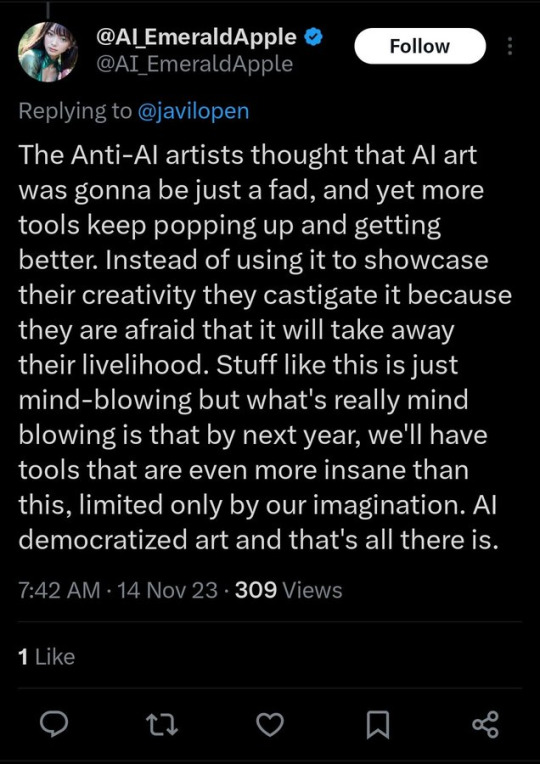
As well as countless of others from the AI generator community. Just talking about how "inaccessible art" is, I decided why not show how wrong these guys are while also helping anyone who actually wants to learn.
Here is the first one ART TEACHERS! There are plenty online and in places like youtube.
📺Here is my list:
Proko (Free)
Marc Brunet (Free but he does have other classes for a cheap price. Use to work for Blizzard)
Aaron Rutten (free)
BoroCG (free)
Jesse J. Jones (free, talks about animating)
Jesus Conde (free)
Mohammed Agbadi (free, he gives some advice in some videos and talks about art)
Ross Draws (free, he does have other classes for a good price)
SamDoesArts (free, gives good advice and critiques)
Drawfee Show (free, they do give some good advice and great inspiration)
The Art of Aaron Blaise ( useful tips for digital art and animation. Was an animator for Disney)
Bobby Chiu ( useful tips and interviews with artist who are in the industry or making a living as artist)
Second part BOOKS, I have collected some books that have helped me and might help others.
📚Here is my list:
The "how to draw manga" series produced by Graphic-sha. These are for manga artist but they give great advice and information.
"Creating characters with personality" by Tom Bancroft. A great book that can help not just people who draw cartoons but also realistic ones. As it helps you with facial ques and how to make a character interesting.
"Albinus on anatomy" by Robert Beverly Hale and Terence Coyle. Great book to help someone learn basic anatomy.
"Artistic Anatomy" by Dr. Paul Richer and Robert Beverly Hale. A good book if you want to go further in-depth with anatomy.
"Directing the story" by Francis Glebas. A good book if you want to Story board or make comics.
"Animal Anatomy for Artists" by Eliot Goldfinger. A good book for if you want to draw animals or creatures.
"Constructive Anatomy: with almost 500 illustrations" by George B. Bridgman. A great book to help you block out shadows in your figures and see them in a more 3 diamantine way.
"Dynamic Anatomy: Revised and expand" by Burne Hogarth. A book that shows how to block out shapes and easily understand what you are looking out. When it comes to human subjects.
"An Atlas of animal anatomy for artist" by W. Ellenberger and H. Dittrich and H. Baum. This is another good one for people who want to draw animals or creatures.
Etherington Brothers, they make books and have a free blog with art tips.
As for Supplies, I recommend starting out cheap, buying Pencils and art paper at dollar tree or 5 below. For digital art, I recommend not starting with a screen art drawing tablet as they are more expensive.
For the Best art Tablet I recommend either Xp-pen, Bamboo or Huion. Some can range from about 40$ to the thousands.
💻As for art programs here is a list of Free to pay.
Clip Studio paint ( you can choose to pay once or sub and get updates)
Procreate ( pay once for $9.99)
Blender (for 3D modules/sculpting, ect Free)
PaintTool SAI (pay but has a 31 day free trail)
Krita (Free)
mypaint (free)
FireAlpaca (free)
Libresprite (free, for pixel art)
Those are the ones I can recall.
So do with this information as you will but as you can tell there are ways to learn how to become an artist, without breaking the bank. The only thing that might be stopping YOU from using any of these things, is YOU.
I have made time to learn to draw and many artist have too. Either in-between working two jobs or taking care of your family and a job or regular school and chores. YOU just have to take the time or use some time management, it really doesn't take long to practice for like an hour or less. YOU also don't have to do it every day, just once or three times a week is fine.
Hope this was helpful and have a great day.
105K notes
·
View notes
Text
I miss the days when, no matter how slow your internet was, if you paused any video and let it buffer long enough, you could watch it uninterrupted
323K notes
·
View notes
Text

ALL OF THESE REQUIRE GETTING OUT OF BED
47K notes
·
View notes
Photo
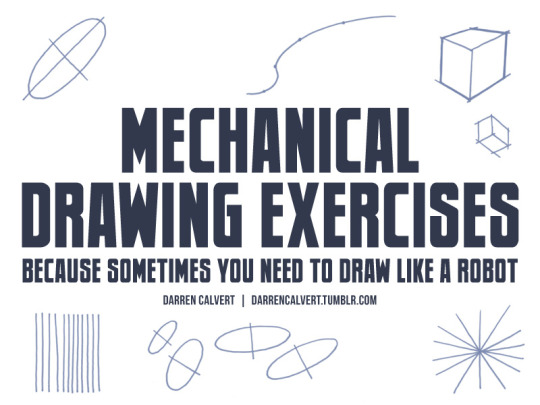
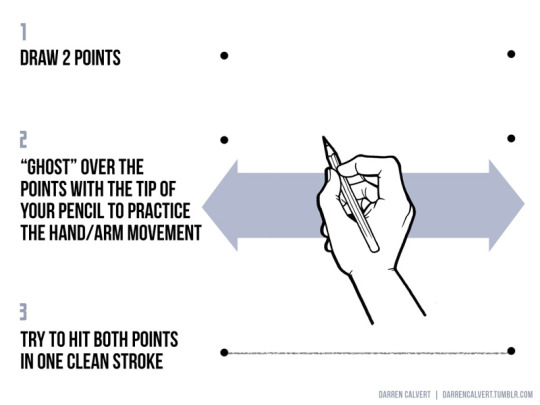
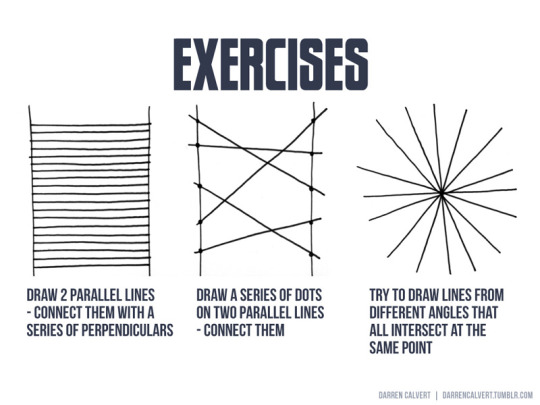

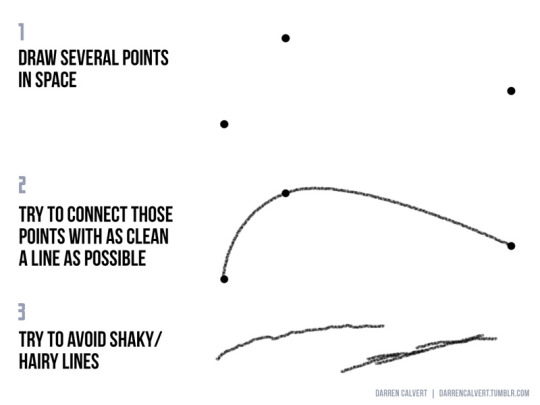

People often say to me: “You draw like some kind of inhuman machine. If I eat your brain, will I gain your power?” The answer is yes, but there is another way. The key to precise drawing is building up muscle memory so that your arm/hand/fingers do the things you want them to do when you want them to do them. Teaching yourself to draw a straight line or to make sweet curves is just a matter of practice and there are some exercises you can do to help improve. If you’re going to be doodling in class or during meetings anyway, why not put that time to good use?
178K notes
·
View notes
Text
In case no one told you growing up
Bras last longer if you let them air dry. Don’t put them in the dryer.
If you have a problem with frizzy hair, don’t dry your hair with a towel. It makes the frizzies worse. (I recently read an article that said to use a t-shirt? I brush mine out and let it air dry.)
Whites wash best in hot water. Everything else can be in cold - save on your electricity bill.
You can kill 99.9% of germs in a sponge by putting it in the dishwasher for a cycle or by microwaving it for 2 min (be sure to make the sponge damp before microwaving and to put a cup half full of water in with it and please DO NOT squeeze the sponge until it has cooled off)
Airing out your room/house and letting sunlight in every so often can decrease the number of household pests like silverfish and ants.
Black underwear is best during your period as stains are less likely to be visible.
To save money, put aside 10% of each paycheck into a savings account. It’ll add up.
Unless your hair has something on/in it (like grease or mud or something), using conditioner first can actually be the better choice. The conditioner holds in the good oils that help you hair look sleek and beautiful, which shampoo would otherwise wash away.
Speaking of shampoo - if you have long hair, washing just the bits that touch your scalp is generally enough. The rest of your hair gets cleaned with just the run off from your scalp.
If you put a tampon in and it’s uncomfortable/you can feel it, you didn’t do it quite right. A properly placed tampon is virtually unnoticeable by the wearer.
Apply deodorant/antiperspirant a couple hours in advance of when you need it. This gives the product the chance to block your sweat glands. Using deodorant just before going somewhere where you’ll sweat (this means walking outside for people in high humidity places) results in your sweat washing the deodorant off and starkly limiting its usefulness.
After running the dryer, use the dryer sheet from that load to brush out the lint catch - it gets everything off in a fraction of the time it’ll take you to get it clean with your bare hands. Paper towels also work well.
Wash your face everyday, or as often as possible. Forget which brand of cleanser is best. Just washing your face everyday will guarantee you clearer skin. And do you best not to pop pimples, as tempting as the urge may be.
Fold laundry asap after taking it from the dryer to avoid wrinkles. This may seem obvious for dress shirts and silly for things like t-shirts, but you’ll notice the difference even then once your shirts stop looking like unfolded paper balls.
411K notes
·
View notes
Text
A brief intro to stamp making!
These are regular pink erasers from the supermarket. I'm going to make a flower. First, I trace the eraser itself to get a feel for the size.

I trace the design for each color of ink on separate pieces of tracing paper, then tape them onto the erasers and rub the graphite side down to transfer the image. Any paper that holds graphite will work for this.
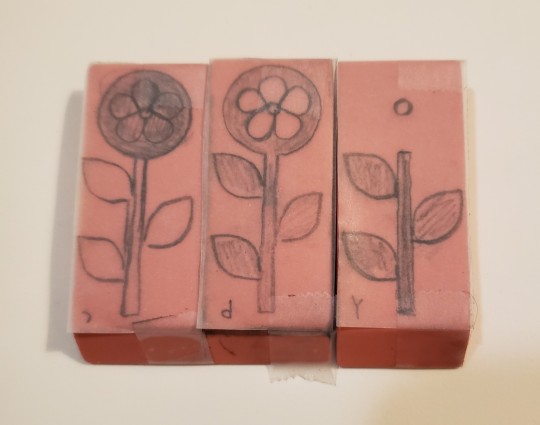
Since I'm using red, blue, and yellow ink, I'm layering the stamps over top of one another to produce secondary colors like green and purple. I use a V-shaped carving tool most of the time, just a cheap one I got in a kit at Michael's. Almost anything sharp will work.
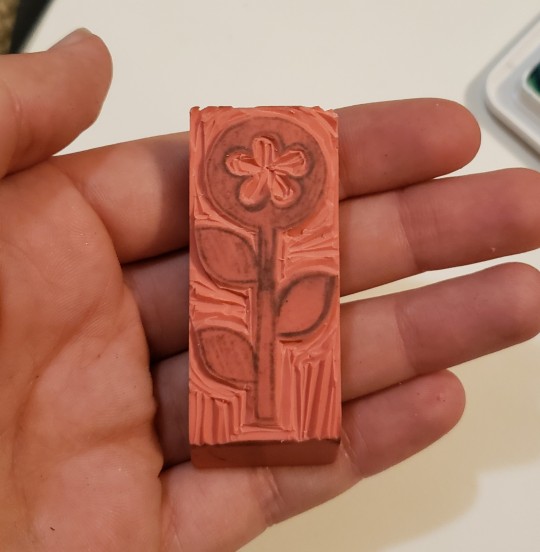
I got these Ranger ink pads also at Michael's, they're working for me so far. Slightly nicer ink pad brands usually also sell bottles of refill ink, so you don't need to buy a whole new pad when one runs dry.
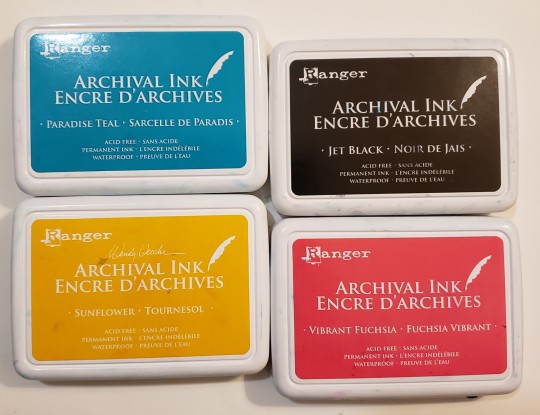
Most of the time involved is spent carving the rubber and testing the print as you go. Be careful to carve in the direction away from your hands.
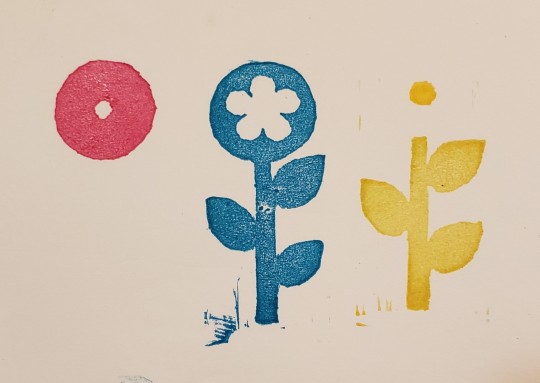
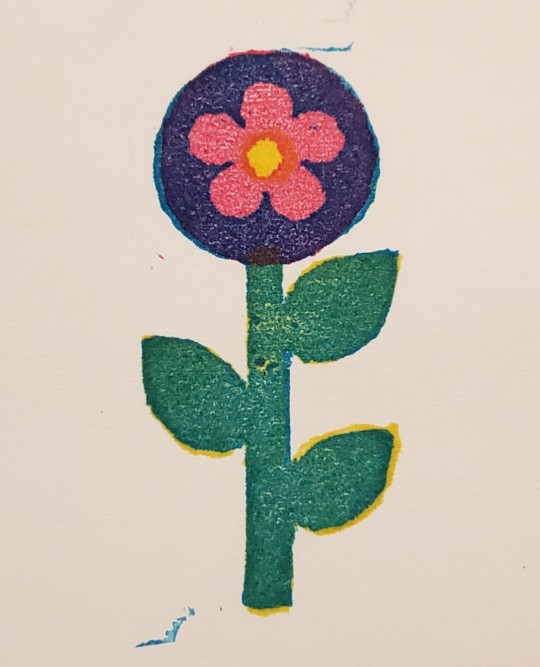
I think these worked out pretty well! Thanks for reading, and have fun!
12K notes
·
View notes
Text
Homemaking, gardening, and self-sufficiency resources that won’t radicalize you into a hate group

It seems like self-sufficiency and homemaking skills are blowing up right now. With the COVID-19 pandemic and the current economic crisis, a lot of folks, especially young people, are looking to develop skills that will help them be a little bit less dependent on our consumerist economy. And I think that’s generally a good thing. I think more of us should know how to cook a meal from scratch, grow our own vegetables, and mend our own clothes. Those are good skills to have.
Unfortunately, these “self-sufficiency” skills are often used as a recruiting tactic by white supremacists, TERFs, and other hate groups. They become a way to reconnect to or relive the “good old days,” a romanticized (false) past before modern society and civil rights. And for a lot of people, these skills are inseparably connected to their politics and may even be used as a tool to indoctrinate new people.
In the spirit of building safe communities, here’s a complete list of the safe resources I’ve found for learning homemaking, gardening, and related skills. Safe for me means queer- and trans-friendly, inclusive of different races and cultures, does not contain Christian preaching, and does not contain white supremacist or TERF dog whistles.
Homemaking/Housekeeping/Caring for your home:
Making It by Kelly Coyne and Erik Knutzen [book] (The big crunchy household DIY book; includes every level of self-sufficiency from making your own toothpaste and laundry soap to setting up raised beds to butchering a chicken. Authors are explicitly left-leaning.)
Safe and Sound: A Renter-Friendly Guide to Home Repair by Mercury Stardust [book] (A guide to simple home repair tasks, written with rentals in mind; very compassionate and accessible language.)
How To Keep House While Drowning by KC Davis [book] (The book about cleaning and housework for people who get overwhelmed by cleaning and housework, based on the premise that messiness is not a moral failing; disability and neurodivergence friendly; genuinely changed how I approach cleaning tasks.)
Gardening
Rebel Gardening by Alessandro Vitale [book] (Really great introduction to urban gardening; explicitly discusses renter-friendly garden designs in small spaces; lots of DIY solutions using recycled materials; note that the author lives in England, so check if plants are invasive in your area before putting them in the ground.)
Country/Rural Living:
Woodsqueer by Gretchen Legler [book] (Memoir of a lesbian who lives and works on a rural farm in Maine with her wife; does a good job of showing what it’s like to be queer in a rural space; CW for mentions of domestic violence, infidelity/cheating, and internalized homophobia)
“Debunking the Off-Grid Fantasy” by Maggie Mae Fish [video essay] (Deconstructs the off-grid lifestyle and the myth of self-reliance)
Sewing/Mending:
Annika Victoria [YouTube channel] (No longer active, but their videos are still a great resource for anyone learning to sew; check out the beginner project playlist to start. This is where I learned a lot of what I know about sewing.)
Make, Sew, and Mend by Bernadette Banner [book] (A very thorough written introduction to hand-sewing, written by a clothing historian; lots of fun garment history facts; explicitly inclusive of BIPOC, queer, and trans sewists.)
Sustainability/Land Stewardship
Braiding Sweetgrass by Robin Wall Kimmerer [book] (Most of you have probably already read this one or had it recommended to you, but it really is that good; excellent example of how traditional animist beliefs – in this case, indigenous American beliefs – can exist in healthy symbiosis with science; more philosophy than how-to, but a great foundational resource.)
Wild Witchcraft by Rebecca Beyer [book] (This one is for my fellow witches; one of my favorite witchcraft books, and an excellent example of a place-based practice deeply rooted in the land.)
Avoiding the “Crunchy to Alt Right Pipeline”
Note: the “crunchy to alt-right pipeline” is a term used to describe how white supremacists and other far right groups use “crunchy” spaces (i.e., spaces dedicated to farming, homemaking, alternative medicine, simple living/slow living, etc.) to recruit and indoctrinate people into their movements. Knowing how this recruitment works can help you recognize it when you do encounter it and avoid being influenced by it.
“The Crunchy-to-Alt-Right Pipeline” by Kathleen Belew [magazine article] (Good, short introduction to this issue and its history.)
Sisters in Hate by Seyward Darby (I feel like I need to give a content warning: this book contains explicit descriptions of racism, white supremacy, and Neo Nazis, and it’s a very difficult read, but it really is a great, in-depth breakdown of the role women play in the alt-right; also explicitly addresses the crunchy to alt-right pipeline.)
These are just the resources I’ve personally found helpful, so if anyone else has any they want to add, please, please do!
36K notes
·
View notes

